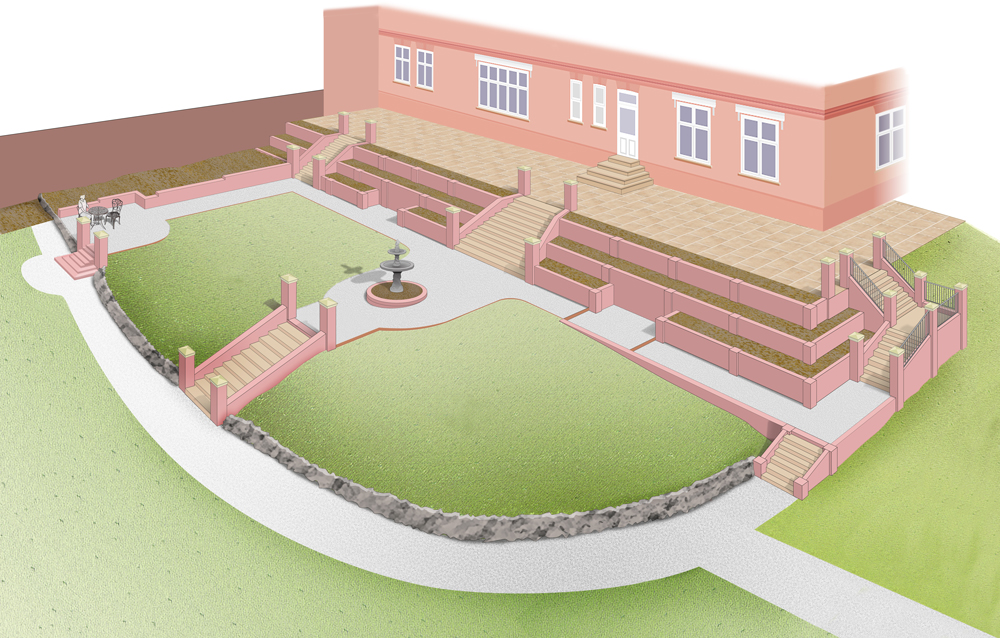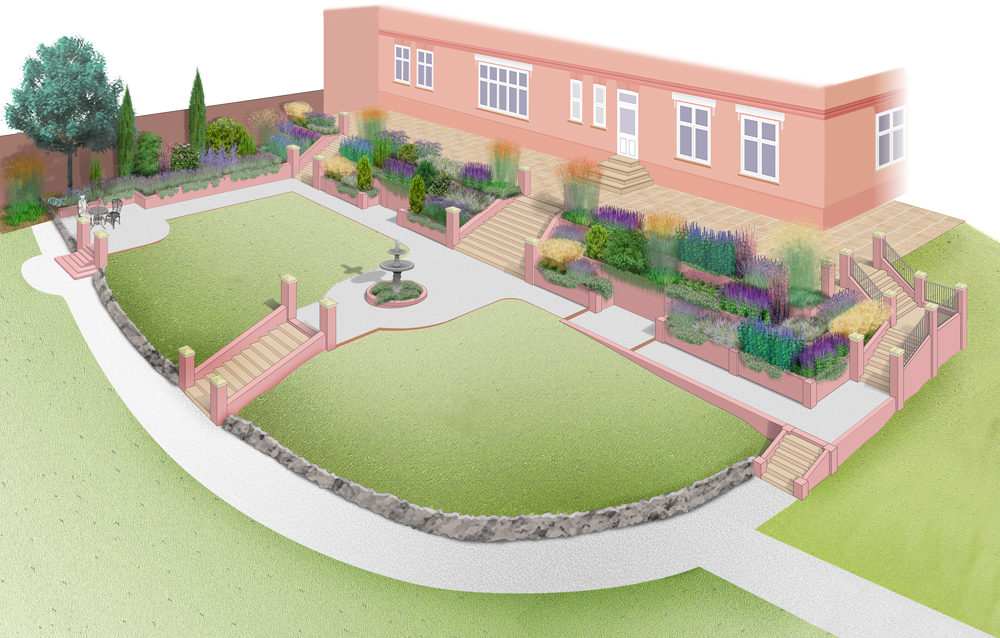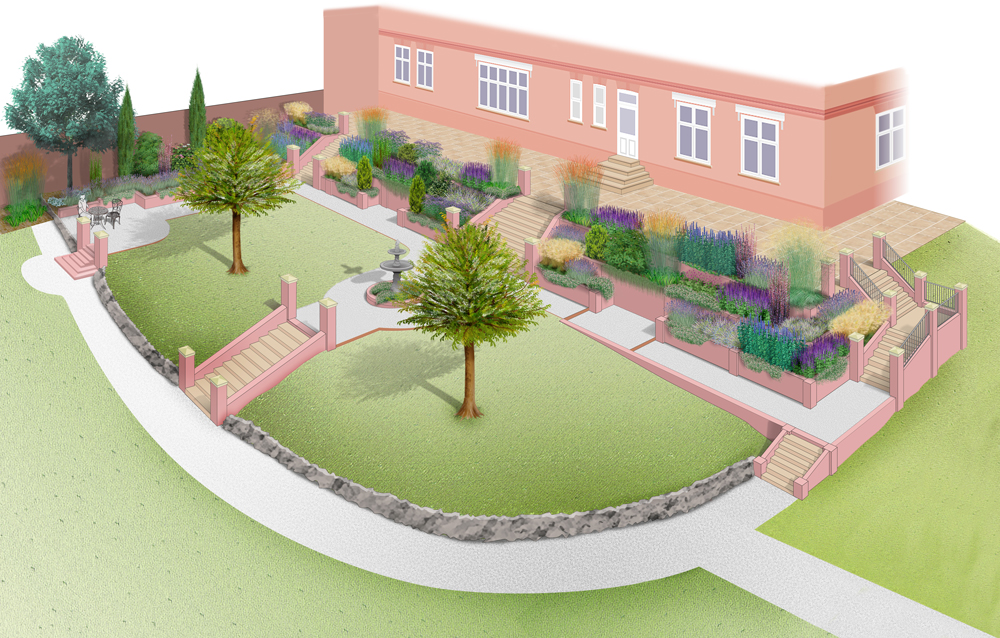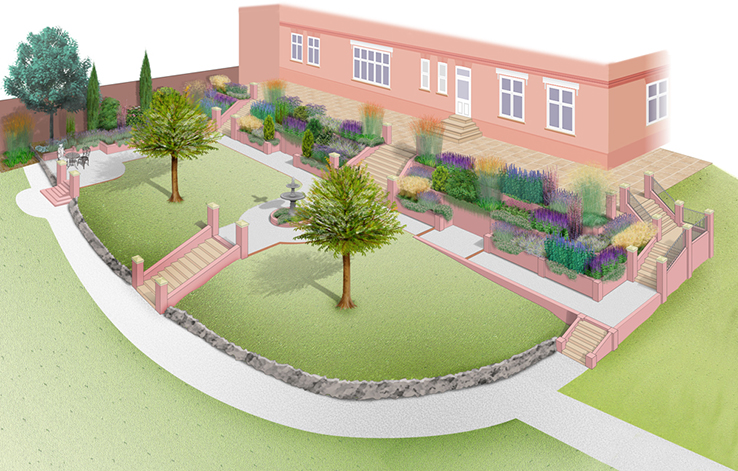Garden Design Brief
I don't usually post projects which haven't proceeded to full landscaping but this project was such an interesting piece of work and so close to fulfilment, I felt the story needed to be told.
Last year I was contacted by a delightful couple to design a new raised terrace adjoining their Grade II listed property in the Maldon area of Essex. With their initial telephone brief in mind, I checked the official Grade II listing of the property with Historic England and discovered the house, which dates back to 1885, was designated a listed building in 2008 due to its outstanding aesthetic merit in design. So I knew prior to my initial visit that sensitivity in design would be foremost in the approach to this project.
On a sunny day towards the end of August last year I visited to the property and could see straightaway that this was going to be no ordinary terrace replacement. Whilst the garden was significant in size and in an absolutely stunning position, the existing terrace that the current owners had inherited had been poorly constructed and was now showing severe signs of breaking up, which presented some very hazardous hard surfaces. It was clear that the construction was not part of the original build and, as such, explained why there was no mention of the terrace on the listing document.
The current terrace, I suspected, had not had the benefit of any design or structural input and appeared to be of a ‘homemade' construction. The existing upper terrace was very narrow and out of proportion with the height of the building to the eaves. The surface was of a concrete slab construction, uneven and badly broken up with a random selection of sandstone covers to an ancient water tank and plastic covers to drainage access points. The edge was made up of a concrete render on top of what could only be described in the loosest terms as a ‘retaining wall' construction of uncalibrated concrete ‘boulders' roughly pointed with cement. The retaining wall was also ‘live' and cracked in many places.
Aside from the access from the side of the property there were three separate flights of steps leading up to the terrace, all of which were poorly built and showing signs of collapse. There was an additional flight of sandstone steps from the rear entrance down to the terrace, which had suffered erosion due to frost damage.
The existing planted terracing down to the garden was narrow, uneven and matched the poor construction of the terrace itself.
The current owners had completed an impressive renovation of the house itself, which was beautiful and a testimony to their huge appreciation of its aesthetic value. The garden was their next project.
The pictures below provide some indication of the issues presented by the terrace and surrounding garden.
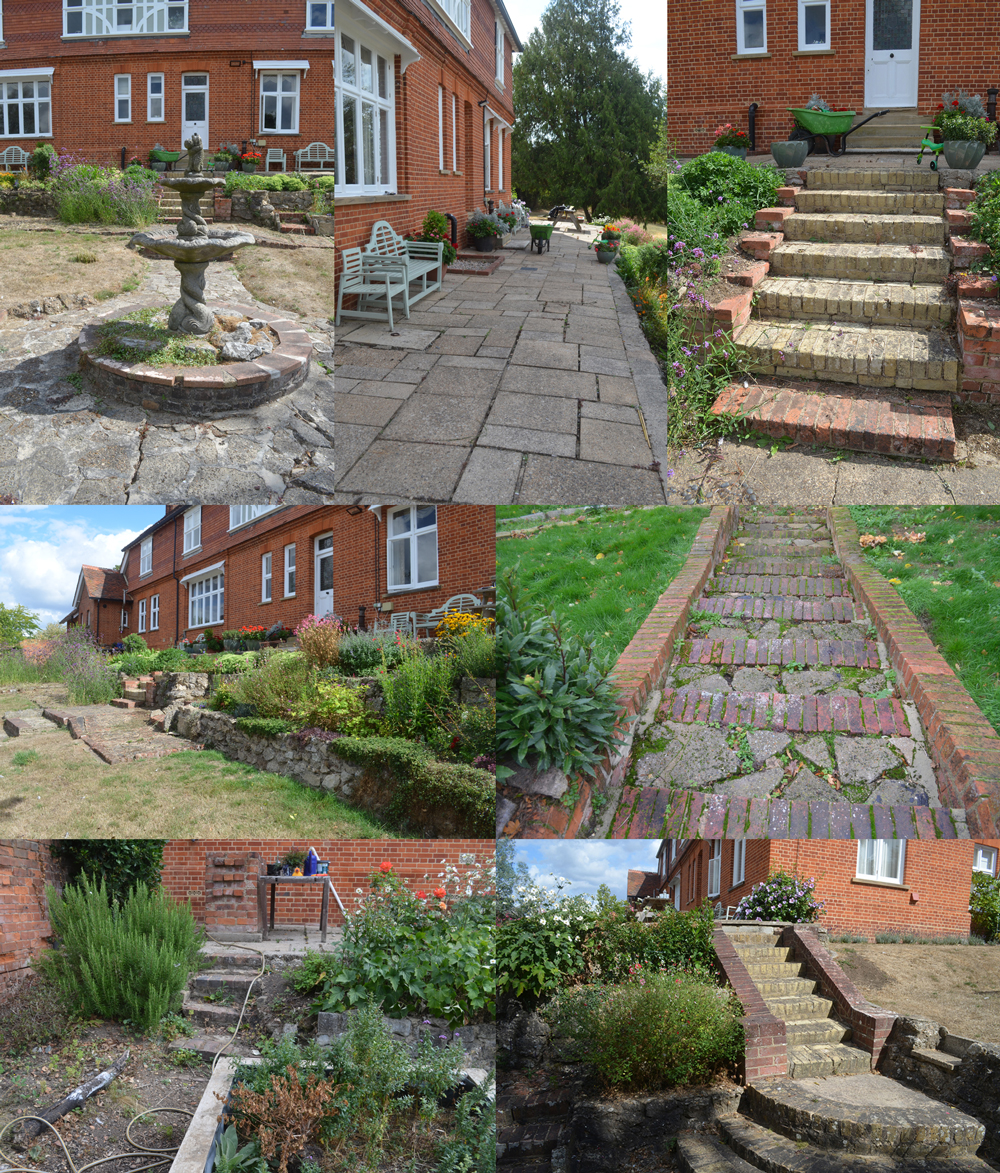
Garden Renovation Solution
I was therefore tasked with redesigning the terrace and close surrounding garden. This area could be roughly broken down into 4 levels:
1st level - the main house rear access to the terrace
2nd level - the terrace itself
3rd level - the garden
4th level - the lower garden
Following the survey, it was established that the garden dropped nearly 5 metres over a 19-metre distance east to west, and nearly 3 metres over a 30-metre distance north to south. This alone determined that there would be numerous flights of steps and these would have to be reconfigured for tread and riser measurements to ensure they were comfortable to ascend and descend.
The terrace also needed to be widened; however extending the terrace surface further out from the house added height to the overall drop to the 3rd garden level, as it sloped away.
The terrace level itself couldn't be altered due to its association with the rear entrance to the house. I therefore introduced three separate planting terrace levels in the design. These consisted of a main retaining wall supporting the terrace, with a second retaining wall (level with the first), with a 800mm deep planting bed brought up to the level of the terrace surface. There were then two further lower retaining walls with planting beds 800mm deep equally staggered down to the 3rd garden level. This would allow for a good level of planting to enhance the terrace and soften the significant amount of brick work and supporting piers that would be needed for its construction.
PLAN ELEVATION
Images of concept: House orientation 358.85° N
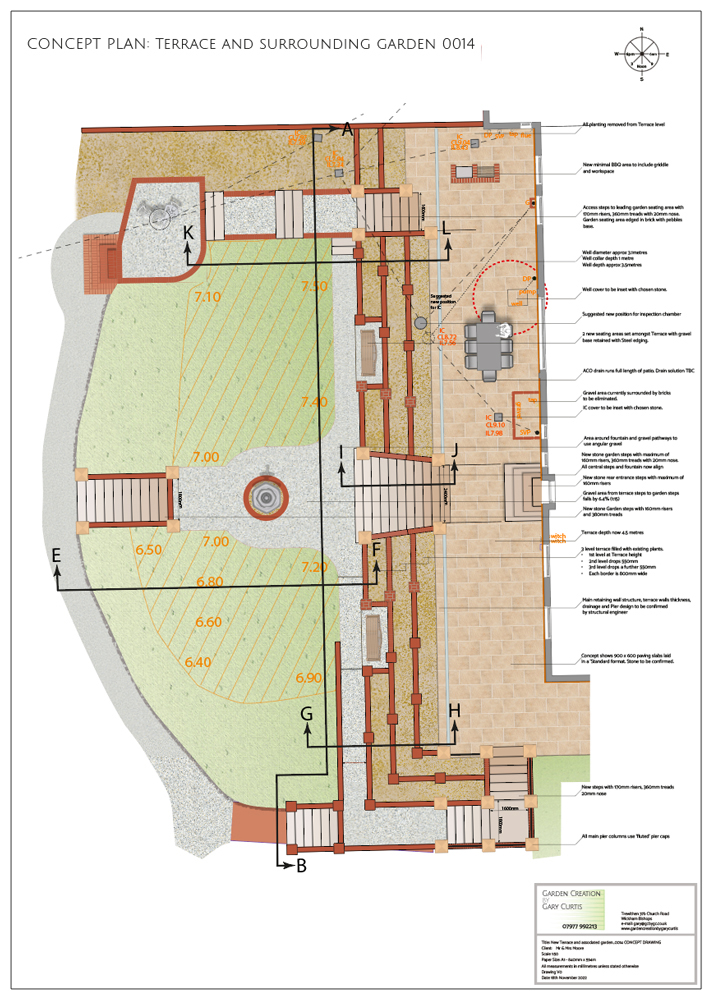
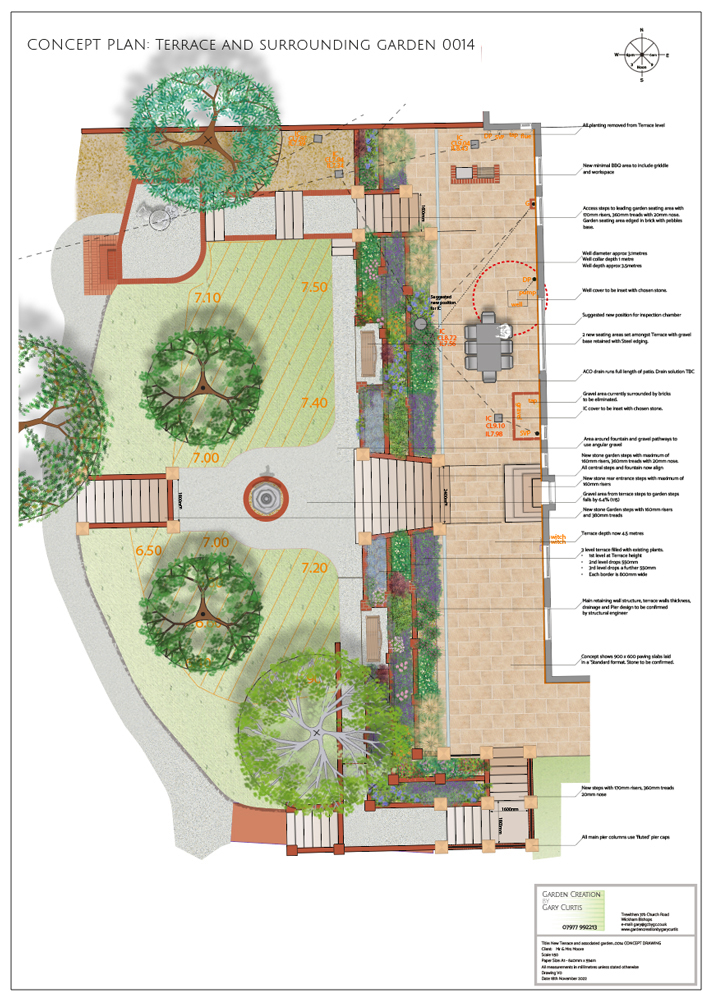
From the base of the new terrace, at the 3rd level, I introduced three additional flights of steps and two shallow gradients. The slopes leading to the final flights of steps were all eventually linked by the existing 4th level lower garden pathway surrounding the area designated as the ‘closely associated garden', included in the design.
Other features to be included within the new design were an additional seating area to the north west corner with pathways and steps to the terrace and other parts of the garden, integrated seating areas to the terracing, an extension of the terrace to the south side to the property and the repositioning of an existing fountain.
Below shows the concept drawings of west elevations. The varying colours were used to allow the clients to recognise the different levels and elevations of brickwork.
WEST ELEVATION

SOUTH ELEVATION
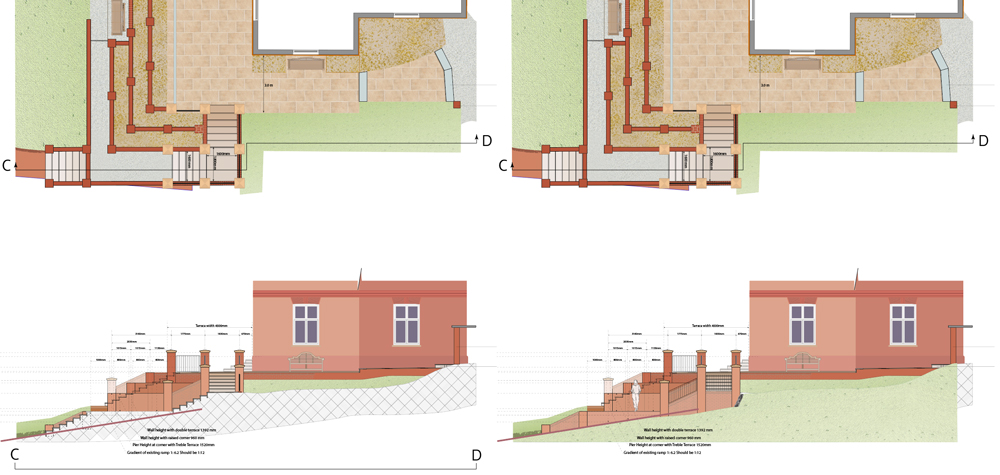
Structural work
Structurally, the terrace presented challenges; being approximately 2 metres above the garden surface at one end, so any retaining walls would require structural engineering calculations and drawings before landscaping could take place. Adding to this there was a large, existing ancient surface water tank under the existing terrace, which was part of the original build of the property, the integrity of which could not be guaranteed. This potentially would add unwarranted lateral stress to any new retaining walls that would have to be dealt with.
Materials
I noted that the current garden employed approximately seven different materials including multiple colours and patterns of brick, natural stones, concrete boulders, random designs of pebbles set into concrete slabs and unwanted focal points. This required simplification and the building materials needed to be reduced to no more than three. One of these had to be an equivalent to the soft red bricks that the house had been originally built with. For the terrace surface I advised that sandstone with a low water absorbency would be a sensible choice, as there was evidence of sandstone being used in the fabric of the building. These choices would also provide continuity with the new sandstone step material.
In order to reduce cost and to some degree formality on the project, outside of the terrace, all walkways, seating areas and slopes would use granite chippings to match that already used in other areas of the extended garden.
Planting
As previously mentioned, no decision had been made on planting apart from agreement on the removal of a large poorly developed multi-stemmed tree sited close to the existing terracing. Outside of this, all of the existing plants were to be lifted, replanted in a part of the garden outside the development area and possibly re-used post landscaping.
Approvals
The whole project was likely to require approval from either the Local District Council or listed building consent or both. It is highly likely that this would include the choice of materials being used, as whilst I had initially decided to use materials in keeping with the house, there may be a need to separate the two. By February of 2023 this was going to be the next step in the project.
The Vision
The concepts drawings were approved by the client with some minor changes and the design proceeded to the working drawings, but following their submission the project has sadly been placed on hold. My vision of the final design is shown below. This project may go forward again in the future... I very much hope so, as it would be a shame to end the story here for such a wonderful property and location.
